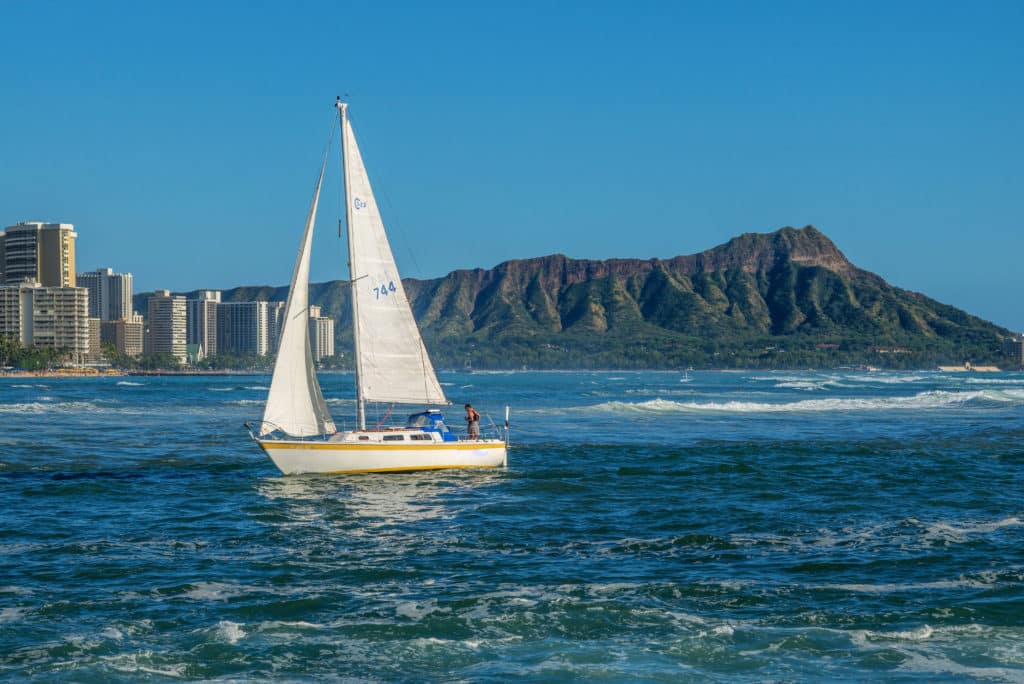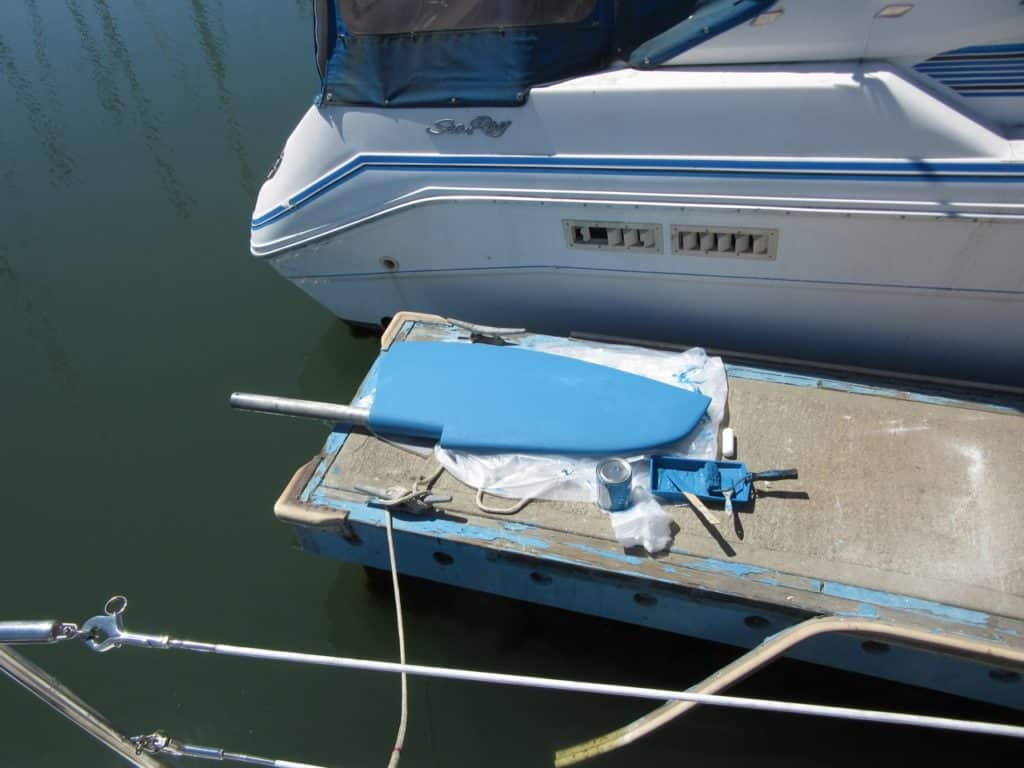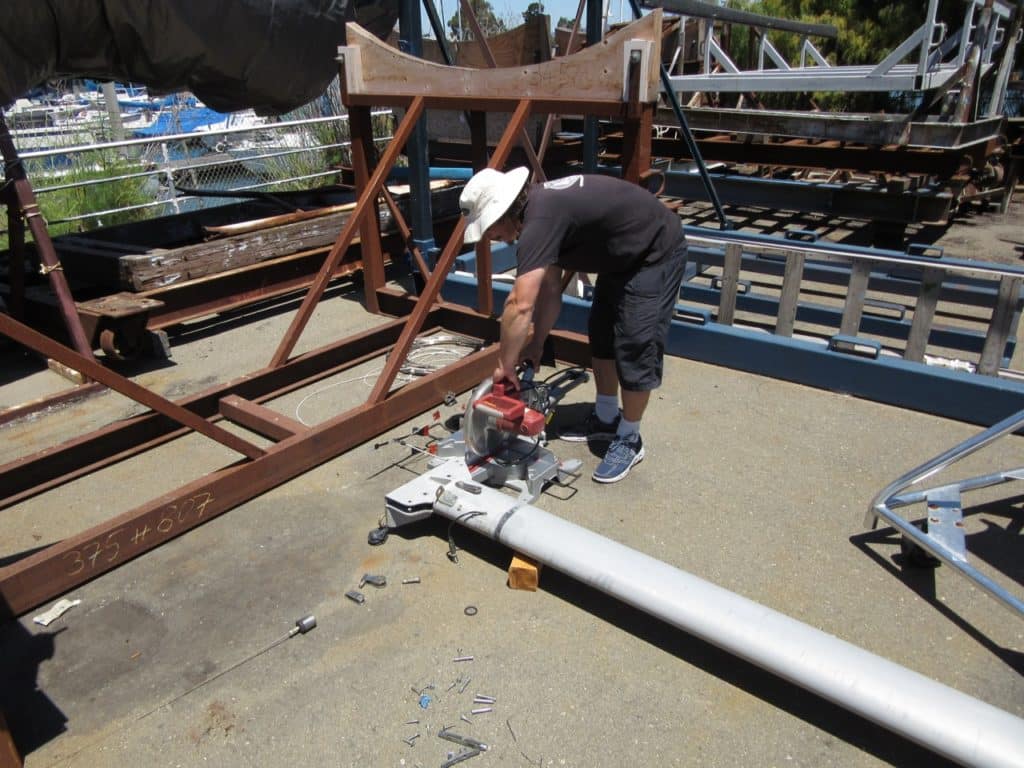
Two years ago, when I set out to cross the Pacific aboard my Cal 2-27, Mongo, my plan was straightforward: go cruising for a year, sell the boat wherever I ended up, and fly home to California to resume my life. I’d purchase another boat using my savings and the proceeds from selling Mongo. But after my year of voyaging, with a pricey dismasting along the way, there wasn’t much left over. In addition, engineless 27-footers like Mongo don’t exactly fetch a premium on the open market in New Zealand, which is where I sold her.
Bottom line? I had about $10,000 to spend on my next boat, not counting refit costs.
So my budget (and my next boat) would be smaller than I had originally planned. When I flew from Auckland to San Francisco on St. Patrick’s Day of 2015 with two large duffel bags, a quiver of surfboards and a fat stack of Kiwi currency, I was on a mission to buy a boat.
Fortunately, I’d come home to California, where good, cheap sailboats are readily available. During my final weeks abroad, I’d closely monitored Bay Area Craigslist postings and had already made a few appointments to look at boats, many of which were Cal yachts designed by Bill Lapworth. This wasn’t coincidental, as I’ve always been drawn to Lapworth designs. I’d already owned two Cals, including Mongo, which had taken me all the way to New Zealand. By producing good boats cost-effectively, Jensen Marine, the builder of the Cal brand, had sold thousands upon thousands of boats during the fiberglass boatbuilding boom of the 1960s and 1970s. Cals have stood the test of time, are still in huge supply, and generally represent good value; they’re the proverbial dime-a-dozen classic plastic production cruisers.
Once I was back at my old marina, some dockside friends pointed me toward a nice little 29-foot sloop. Of course, it was a Cal. Within a week of arriving home, I was the proud owner of a Cal 2-29 called Sleepy II, hull number 774, hailing port Alameda. For $6,500, I’d acquired a sweet little cruising boat with a solid hull, a Bristol interior, a new Universal diesel and a hard-bottom RIB. I was stoked.
After rolling a mountain bike and two dock carts of gear down to the boat, I felt like I’d never left town. The transition from one fine Lapworth-designed yacht on New Zealand’s North Island to another in Northern California had been seamless. In a region of the country that’s experiencing a severe housing crisis, for just a few grand up front and a low monthly overhead, I was again a homeowner. As my friend Jeremy said, “You found your loophole.” The Bay Area slipped back on like a glove. I was home.
I knew from the moment I laid eyes on the boat that the steering wheel would go, replaced by a new rudder with a tiller. Cal masts are simple, rather agriculturally built aluminum tree trunks — nothing fancy, but with new standing rigging and an overhaul, I reckoned mine would be quite solid. The keels are glassed-in lead (no 40-year-old keel bolts to worry about), and the hull-to-deck joints were all glassed over from the factory — simple, burly stuff, and very much why I like these boats. So from Day One, I had a solid plan for preventing the keel and/or rudder from falling off and the rig from coming down. Once those basics were covered, the rest would be mere details. Slap on a self-steering windvane, a couple of solar panels, some ground tackle and a few sails, and she’d be ready to go places. Grandpa’s weekend condo would be transformed into an offshore passagemaker. All she needed was a new name. Loophole was perfect.
One of my very first goals was to unplug Loophole from the dock, as dependence on shore power defies my every notion of a cruising sailboat. With two large solar panels (90-watt and 85-watt, respectively) wired into my boat’s bank of two Group 24 batteries, I’d have plenty of power, provided I played it smart and used a windvane for self-steering. Also, by installing a 600-watt Xantrex inverter, I’d have enough juice to run power tools and conduct virtually the entire refit while wholly energy-independent, aside from the work I’d tackle at the boatyard.

Whenever you’re using solar power and living off the house batteries, proper monitoring is key, so I added a Victron battery monitor, which I’d had good luck with in the past. All of this, combined with the diesel engine’s charging system and all-new LED lights, would make Loophole fully self-sufficient, at sea or at the dock.
Years ago, on my first boat (a Palmer Johnson Bounty II), rudder failure doomed my inaugural offshore journey. Since then, I’ve installed new rudders on all three of my boats before tackling blue water. On both my Cals, including my previous Mongo, I purchased new rudders from the original builder, Foss Foam, of Newport Beach. These weren’t stock rudders, but scaled-down blades that naval architect Carl Schumacher retrofitted and updated for a Lapworth-designed Cal 40 in the 1990s. Even after a coral reef grounding in Fiji on Mongo, the rudder shaft remained straight, and there was only minor fiberglass damage at the bottom of the foil, which was easily repaired.
So for just over a grand, I had a beautiful new rudder. Converting the boat from wheel steering to tiller steering (and revamping the engine controls) was a long, expensive project, but the effort and money invested were well worth it. The new tiller and foil transformed the entire boat, both at the dock and under sail. I also managed to swap rudders in the slip, without hauling out — a huge savings. As an added bonus, I found an appropriate home for the boat’s original wheel and binnacle, which are now the focal point of a 5-year-old’s backyard playground in Berkeley.
Once the tiller and engine controls went in, out came the rig. Some friends and I pulled the mast using the dry storage yard’s boat hoist before carting the spar over to a nearby metal shop. (Owning small boats offers many advantages, including cost-effective options for pulling rudders and rigs.) Originally equipped with external main and jib halyards, wooden spreaders and no spinnaker gear, Loophole’s rig was in dire need of a refit.
First I gave the rigging shop at Svendsen’s Boat Works my old standing rigging and had them replicate new rigging that was a size larger than the stock wire, using high-quality Hayn components. Since a failed Alexander Roberts-brand fitting resulted in Mongo’s dismasting on a lee shore, I scrutinize every single piece of hardware that goes into any of my new rig projects, and have become sold on Hayn products.
At Svendsen’s metal shop, Chris Evanoff built custom metal spreaders for Loophole using a set of spreader sections from a newer production boat that he custom-modified to fit my rig. Next my old boss, professional rigger Ryan Nelson of Rogue Rigging, came out and chopped off my masthead with a circular saw. Once that was done and we’d opened up a hole in the top of the spar, Chris and his guys in the metal shop welded the masthead back in place. After I reassembled the masthead with four new sheaves at the top, then opened up halyard exits at the bottom, the stock rig had been converted from two external halyards to four internal ones with a simple, elegant solution. I also added an internal spinnaker halyard and spinnaker-pole topping lift.
With the halyards now running internally, I installed a conduit inside the mast using lightweight PVC from a gardening store and ran all of the 12-volt and coaxial wires up the rig. Once everything was laced up and some last-minute welding jobs were performed, the rig was stepped with a new stainless-steel plate at the base, from which halyard blocks would be hung. It was a true pleasure to work with Chris and the entire Svendsen’s team, including yard manager Hartwell Jordan, a veteran America’s Cup sailor. They were conscious of my budget, did great work, and made me feel like family.
With the rig and rudder ready to rock, I was ready to go sailing. That required some new rags. I ditched the old furler and two furling jibs on Craigslist in favor of assembling an inventory of secondhand hank-on sails. I found a like-new North Sails racing No. 3 jib at a local loft, bought three used Dacron headsails from Minney’s Yacht Surplus in Newport Beach, and got a couple of used spinnakers from friends on the dock. After a third reef point was added to the mainsail, which was still in good condition, Loophole had an entire set of serviceable sails for about the price of a brand-new main. No, they weren’t the flashiest sails on the water, but my cruising inventory was good enough to at least take me somewhere far away.
I am a huge fan of windvanes for crossing oceans solo or shorthanded on a simple cruising boat. A good windvane is extremely reliable and uses no electricity whatsoever — both compelling features. As with Mongo, I found a secondhand Navik windvane, had some simple stainless-steel brackets constructed, and installed it on the transom in a single afternoon. (This is yet another reason I love Cals; most of them have vertical transoms that make windvane installation extremely straightforward.) Once the new Navik vane — which I dubbed Jean Le Cam after the French solo sailor — was fully installed, I also added a simple tillerpilot. The Navik vane would be the primary helmsman while at sea; the tillerpilot would serve as the backup and assist the helmsman in light air and on daysails.

Part of my motivation for getting the boat quickly overhauled was that I knew I was going somewhere. I wasn’t sure exactly where, or when, but I knew I was going. I was contemplating several options in life, and it seemed that utilizing my GI Bill at the age of 30 to return to school for journalism would be a solid play. In late July, I flew to Hawaii to skipper a 46-foot racing yacht back to the mainland following the Transpac Race. My crewmate Walter and I were in the water surfing early the next morning. Watching the sunrise over Diamond Head before a full day of delivery prep, I caught a wave, paddled back out and then sat in the lineup, in awe of the scenery before me. GI Bill. Hawaii. Bingo.
By October, I was accepted and registered at Hawaii Pacific University in Honolulu for the start of the January 2016 semester. By the time the El Niño-induced cyclones stopped and the boat was ready to go, it was already November and time to get moving. The days were short, the nights cold, and foul weather was on the horizon. One after another, big, low-pressure winter systems were marching across the Pacific and slamming into the West Coast. San Francisco was no longer a good departure point; I needed to head south before sailing west.
The day after Thanksgiving, Loophole departed on an overnight passage to Monterey, a stretch that uncovered self-steering issues that needed resolving. After two days of provisioning, final preparations, and Navik windvane surgery on the dock of the Monterey Peninsula Yacht Club, Loophole and I jumped on another brief window between fronts and made the light-air passage to Morro Bay.
Once we’d arrived there, the next front came through as I was motoring away from the Morro Bay fuel dock in the late afternoon. I quickly tied up Loophole at the Morro Bay Yacht Club, shut the companionway and made a cup of tea. After a brief but intense squall, the air fell calm and silent. I checked my phone and saw that the buoy reports were beginning to record northerly winds. It was time to set sail for Hawaii.
I deposited my yacht club key, fired up the diesel engine and shoved off the dock. Motoring out of Morro Bay in the cloak of darkness, Loophole passed the last channel marker, where I hoisted the genoa. There was enough breeze to begin moving under sail, so I killed the engine to conserve our 10 gallons of diesel fuel. Slowly but surely, the 29-foot sloop crept out of Estero Bay before hooking into the northerly pressure.
On a deep broad reach, Loophole raced past Point Conception in a building northwesterly. Running due south, I gradually passed my two potential bailout ports, Santa Barbara and San Diego. Loophole was en route to Hawaii.
Six days out, we’d reached our first waypoint and could begin pointing almost directly for the islands. As we did, a series of hurricane-force winter gales raged across the Pacific before pummeling the West Coast with harsh weather. In the process, the storms compressed and elongated the Pacific High, creating reinforced trade winds for most of the passage. Dousing the main and running almost all the way to Hawaii under headsail alone, despite the lack of sail area, Loophole’s easily driven hull registered consistent 120- to 130-nautical-mile daily runs.
With the trades blowing 30 knots and gusting higher for several days, accompanied by big northerly swells rolling down from the winter storms raging above us, Loophole was tested with arguably the worst sea state I’ve seen in 11 crossings between Hawaii and the West Coast. But the little Lapworth sloop kept trucking along, no matter what the weather and sail plan. At one point I ran under bare poles for 18 hours and still managed to knock off a 101-nautical-mile day in winds that topped out in the low 40s.
Jean Le Cam faithfully steered Loophole for the entire duration of the crossing, and in doing so allowed my batteries to charge fully every single day. Though I was wracked with anxiety for the entire trip — it was breezy and I had a lot riding on it — Loophole performed brilliantly and burned just a single gallon of diesel fuel the whole way.
After 20 days at sea, the 10,025-foot peak of Mount Haleakala on the island of Maui emerged on the horizon just as the sun slowly dipped below it. The nuking trades had mellowed to 18 knots. As a new life in the islands lay before me, a nearly full moon rose behind me. We’d made it.
At 0500 on Christmas Eve, Loophole was tied up in a slip in the tiny, bustling harbor of Lahaina. The captain of a nearby scuba diving boat was prepping for the morning’s first charter.
“Where’d you sail in from?” he asked.
“California,” I replied.
He looked at me with a bit of astonishment and said, “I envy you, man. I really do.”
I stepped off the dock, my legs a bit wobbly after almost three weeks at sea. I looked back at my now battle-proven bluewater cruiser with pride and admiration. I envied me, too. Loophole was a good-looking little yacht. In Maui. On Christmas. My pal was right. I’d found my Loophole indeed.
Studying, surfing, paddling, and helping manage and sail racing yachts in California and Hawaii in his spare time, Ronnie Simpson reports that settling in Hawaii was “a really good move. I’m firing on all cylinders.” He’s also the co-founder of a new nonprofit organization called CORE (Coastal and Offshore Rehabilitation Experience) that introduces combat-wounded military veterans to sailing. To learn more about this important organization, please visit its website (coreveterans.org).








